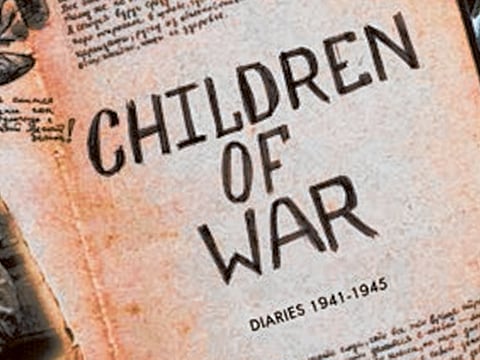The horror of hunger
A collection of personal journals brings back the trauma of the Second World War suffered by the children of the Soviet Union

We live as long as we remember.
A slight tweak of the age-old Russian proverb — You Live as Long as You are Remembered, made by former Soviet President Mikhail Gorbachev, in the introduction to the book “Children of War: Diaries 1941-1945”.
There are no well-known writers in this book — only tiny ones in their teens. There are no tales of heroism, bravery and gallantry and sacrifice of the soldiers. Instead, there is one, and only one theme that runs through it — hunger.
Hunger. Raw, stark hunger. Not the hunger that you feel when you missed your popcorn during a movie. Not the hunger you feel when you missed that doughnut and latté. This is hunger at its barest, fiercest and most horrific — the one that maims, that kills.
“Children of War: Diaries 1941-1945” is the result of a Herculean effort by the journalists of Russian weekly magazine “Argumenty i Fakty”, who through painstaking research, collected 35 diaries maintained by children of the USSR during the Second World War. Each of these diaries is unique in itself. The first is probably the one that evokes the biggest horror — the diary of Tanya Savicheva. Nine lines — that is it. Five of them record the death of family members.
“Zhenya died 28 Dec.
“Grandma died 25 Jan.
“... Everybody has died. Only Tanya is left.”
While war means many things for us adults, for children, as we read the book, the experience was very different. While we stare in horror at what those young eyes had witnessed, the children themselves were probably too young to realise the enormity of what they were witnessing. Thus the chronicles they have left behind are written in a most matter-of-factly manner — the horror strikes us, the readers, more directly.
The book is divided into five parts — each dealing with a separate issue of the war. The largest section, indeed almost half of the book, deals with one of the most horrifying events of the war — the siege of Leningrad. The siege, by German forces on the Soviet Union’s second city, resulted in what is generally considered to be worst famine ever in a developed nation — more than a million people died. It is said that Leningrad had close to 3 million inhabitants before the war, a figure that was not reached until after the 1960s.
To quote a passage from saint-petersburg.com, “On 8 September [1941], the Germans severed the last main road into the city and the most lethal siege in the history of the world began. For 872 days the blockade stretched on, during which the Germans sat entrenched, encircling the city only miles from the historic centre. They tossed bombs in its direction, prevented supplies from reaching the starving civilian population, and waited for capitulation. Hitler had optimistically predicted the city would ‘drop like a leaf’, and menus were printed for the gala victory celebration that was planned at Leningrad’s plush Astoria Hotel. Instead, civilians dropped like flies in an enclosed microcosm with virtually no food, no heat, no supplies, and no escape route. People keeled over dead in the streets by the thousands, malnourished, exhausted, and frozen.”
To the residents of the city, and to its children, the siege meant one thing — no food. Rations were reduced regularly, the pain recorded by the children in their diaries. “There is a gnawing feeling in my stomach all the time, and my mouth keeps watering” (Yura Ryabinkin). “The hunger in the city is appalling. There’s nothing to eat. 125g of bread a day [rations], and hardly any food in the shops’. (Lera Igosheva). But the entry that evokes the greatest emotion is that of Yury Utekhin — he drew pictures of steaks, cheese, bread and other goodies he was dreaming of eating when the war was over, and he would be able to eat his choicest treats again.
December 25, 1941, sees the entries across all the diaries regale with exultation — when the bread ration was increased. “What happiness! What happiness! I want to shout out at the top of my voice,” wrote Lena Mukhina. “What happiness! They’ve increased the bread ration. Instead of 125g, we get now 200g,” wrote Mayya Bubnova.
The other sections of the book are diaries of prisoners in the concentration camps and ghettos, the abducted “slave children” who were taken to Germany to work on farms, those living in the villages and towns directly on the frontline and lastly, those who lived far away from the war, but still had experienced the effects of the war.
While the accounts are multifarious in their tone, it is fascinating to note how the children combine the more serious issues with the mundane existence of their daily lives. “Today I worked on my algebra. The city of Oryol has fallen,” writes one. Along with this, one notes how despite the horrors of war around them, the children continue to chronicle their adolescent years and the pains and little pleasures of growing up — dressing up for a dance, the first crush, the first use of lipstick. Equally striking is how most of them constantly write about books — Jules Verne, Gorky, Pushkin being most of their favourites.
All in all, “Children of War: Diaries 1941-1945” is not just another book — each of the diaries can be considered a minor epic in itself. They bring forth to us the unimaginable situations faced during those fateful years, and are a constant reminder, especially in today’s turbulent times, how fragile peace is, and it must be everyone’s mission to preserve it, for the sake of those who will come after we have gone.
Sign up for the Daily Briefing
Get the latest news and updates straight to your inbox


